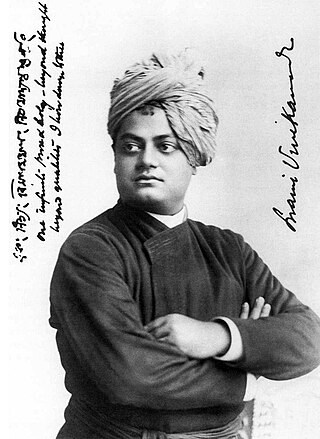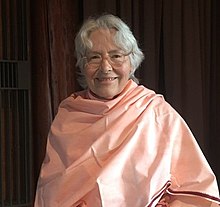
Swami Vivekananda, born Narendranath Datta was an Indian Hindu monk, philosopher, author, religious teacher, and the chief disciple of the Indian mystic Ramakrishna. He was a key figure in the introduction of Vedanta and Yoga to the Western world. He is credited with raising interfaith awareness and bringing Hinduism to the status of a major world religion in the late nineteenth century.

Ramakrishna, also called Ramakrishna Paramahansa, born RamakrishnaChattopadhay, was an Indian Hindu mystic. He was a devotee of the goddess Kali, but adhered to various religious practices from the Hindu traditions of Vaishnavism, Tantric Shaktism, and Advaita Vedanta, as well as Christianity and Islam. He advocated the essential unity of religions and proclaimed that world religions are "so many paths to reach one and the same goal". His parable-based teachings espoused the ultimate unity of diverse religions as being means to enable the realization of the same God. He is regarded by his followers as an avatar.

Ramakrishna Math and Ramakrishna Mission (RKM) is a spiritual and philanthropic organisation headquartered in Belur Math, West Bengal. The mission is named after the Indian Hindu spiritual guru and mystic Ramakrishna. The mission was founded by Ramakrishna's chief disciple Swami Vivekananda on 1 May 1897. The organisation mainly propagates the Hindu philosophy of Vedanta–Advaita Vedanta and four yogic ideals – Jnana, Bhakti, Karma, and Raja yoga. The mission bases its work on the principles of Karma Yoga, the principle of selfless work done with a dedication to God.

Sri Sarada Devi, born Kshemankari / Thakurmani / Saradamani Mukhopadhyay, was the wife and spiritual consort of Ramakrishna Paramahamsa, a nineteenth-century Hindu mystic. Sarada Devi is also reverentially addressed as the Holy Mother by the followers of the Sri Ramakrishna monastic order. The Sri Sarada Math and Ramakrishna Sarada Mission situated at Dakshineshwar is based on the ideals and life of Sarada Devi. She played an important role in the growth of the Ramakrishna Movement.

Sister Nivedita was an Irish teacher, author, social activist, school founder and disciple of Swami Vivekananda. She spent her childhood and early youth in Ireland. She was engaged to marry a Welsh youth, but he died soon after their engagement.
Jeffrey John Kripal is an American college professor. He is the J. Newton Rayzor Chair in Philosophy and Religious Thought at Rice University in Houston, Texas. While chairman of the Religion Department at Rice, he helped found their "GEM" program, with a doctoral concentration in "Gnosticism, Esotericism, and Mysticism".

Vedanta Societies refer to organizations, groups, or societies formed for the study, practice, and propagation of Vedanta, the culmination of Vedas. More specifically, they "comprise the American arm of the Indian Ramakrishna movement" and refer to branches of the Ramakrishna Order located outside India.

Advaita Ashrama, Mayavati, is a branch of the Ramakrishna Math, founded on 19 March 1899 at the behest of Vivekananda, by his disciples James Henry Sevier, and Charlotte Sevier. Today it publishes the original writings of Vivekananda. As an ashram dedicated to the study and practice of Advaita Vedanta, no images or idols are worshipped there, not even of Ramakrishna; and no images were kept in the premises according to the Ashram ideals set by Vivekananda.

Sri Sri Ramakrishna Kathamrita is a five-volume Bengali work by Mahendranath Gupta (1854–1932), which recounts conversations and activities of the 19th century Indian mystic Ramakrishna. The volumes were published consecutively in the years 1902, 1904, 1908, 1910 and 1932. The Kathamrita is regarded as a Bengali classic and revered among the followers of Ramakrishna as a sacred scripture. Its expurgated translation into English is entitled The Gospel of Sri Ramakrishna (1942).
Swami Tyagananda is a Hindu Monk of the Ramakrishna Order and presently the head of the Vedanta Society in Boston. Currently, he is also the Hindu chaplain at MIT and Harvard. He has presented papers at academic conferences, and he gives lectures and classes at the Vedanta Society, MIT, Harvard, and other colleges in and around Boston.
Ramakrishna (1836–1886) was a 19th-century Indian mystic whose teachings form the foundation of the Ramakrishna religious movement, Ramakrishna Order and Ramakrishna Mission.
Ramakrishna (1836–1886) is a famous mystic of nineteenth-century India. Ramakrishna never wrote down the details of his own life. Sources for his life and teachings come from the writings of his disciples and live witnesses. Ramakrishna's recorded sayings mainly come from the last four years of his life.

Sister Gargi, born Marie Louise Burke, was a writer and an eminent researcher on Swami Vivekananda, and a leading literary figure of the Ramakrishna-Vivekananda movement. Gargi was introduced to the Ramakrishna-Vivekananda movement in 1948 by Swami Ashokananda. She is known for her six-volume work, Swami Vivekananda in the West: New Discoveries. Her New Discoveries are considered as indispensable for Swami Vivekananda research.

Josiah John Goodwin was a British stenographer and a disciple of Indian philosopher Swami Vivekananda. Goodwin is known for recording Vivekananda's speeches, and it is thought that without his efforts most of Vivekananda's works would have been lost.
The Advaita Guru-Paramparā is the traditional lineage (parampara) of divine, Vedic and historical teachers of Advaita Vedanta. It begins with the Daiva-paramparā, the gods; followed by the Ṛṣi-paramparā, the Vedic seers; and then the Mānava-paramparā, with the historical teachers Gaudapada and Adi Shankara, and four of Shankara's pupils. Of the five contemporary acharyas, the heads of the five Advaita mathas, four acharyas trace their lineage to those four pupils and one to Adi Shankara himself.

Josephine MacLeod was an American friend and devotee of Swami Vivekananda. She had a strong attachment to India and was an active participant in the Ramakrishna Vivekananda movement. She was given the nicknames "Tantine" and "Jo Jo" by Vivekananda. She considered Swami Vivekananda to be her friend and helped him with his finances. MacLeod was not a sanyasin, unlike many others such as Sister Nivedita or Sister Christine. She was instrumental in spreading Vivekananda's message on Vedanta in the West. She made many contributions to the initial and the later phases of the development of the order of Ramakrishna and Vivekananda. She was a contributor to many causes espoused by Sister Nivedita, the most famous disciple of Vivekananda, including that of contributing financially towards the development of the Indian National Movement especially in Bengal and elsewhere in India.

Sister Christine or Christina Greenstidel was a school teacher, and close friend and disciple of Swami Vivekananda. On 24 February 1894, Christine attended a lecture of Vivekananda in Detroit, United States which inspired her. She started communicating with Vivekananda through letters. Christine went to India in 1902 and began working as a school teacher and a social worker.

Vedanta Society of New York (VSNY) was the first Vedanta Society founded by the Indian Hindu monk Swami Vivekananda in New York in November 1894. In 1897, Swami Abhedananda, another disciple of Ramakrishna, came to the United States and took charge of the society. He was the president of the society until 1921. The Vedanta Society is affiliated with the Ramakrishna Math religious monastic order and the Ramakrishna Mission.

Swami Prakashananda (1874–1927) was a monastic disciple of Vivekananda and a monk of the Ramakrishna Order who played a major role in propagating and promoting the Vedanta philosophy and Vivekananda's message in India and America. He came to the US in 1906 to serve under Trigunatitananda, a direct disciple of Ramakrishna at the Vedanta Society of San Francisco, later renamed as Vedanta Society of Northern California, and later became its president.
Sri Sarada Math is named after Sri Sarada Devi, the consort of Sri Ramakrishna, and founded on 2 December 1954. Built by a group of eight sadhavis, as per the instructions given by Swami Vivekananda, it serves as a monastic order for women. Headquartered at Dakshineshwar, Kolkata, the organisation has branch centres all over India, in Sri Lanka and Australia. The nuns of this order use the title "Pravrajika" before their ordained name, and are usually addressed as "Mataji" meaning 'revered mother'.











